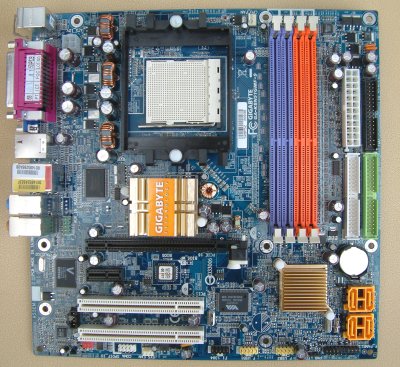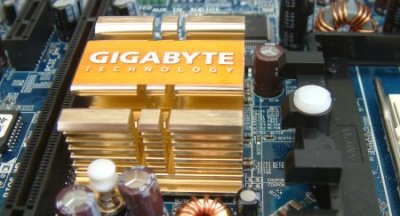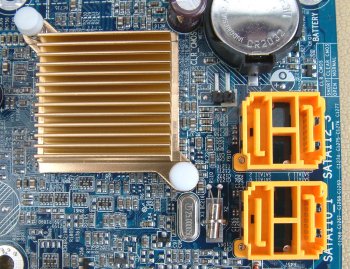Layout and features

As we expect to see from all manufacturers that take on NVIDIA's nForce 410/430 and GeForce 6100/6150 chipset combination, Gigabyte's opted for a micro-ATX form factor that's well-suited to the kind of areas that S.I.s and off-the-shelf purchasers are looking at. As you may know, there are a total of 4 possible chipset combinations available, and Gigabyte's chosen the better-specced nForce 430 and more-basic GeForce 6100 IGP duo. The GeForce 6100 IGP falls short of the '6150, in amongst other things, by not providing DVI connectivity, a TV-encoder, and high-definition video playback, and high-quality video scaling. The graphics core is also run at 425MHz, compared to the '6150's 475MHz, although both support Shader Model 3.0. Users needing the extra feature-set available on the GeForce 6150 would be advised, obviously, to look elsewhere, perhaps to Gigabyte's very own K8N51PVMT-9.

There's enough room around the CPU socket to install larger-than-normal heatsinks, such as the ones packaged with Athlon 64 FXs, with relative ease. Right behind the socket are the power-delivery components and the 4-pin power connector that's now ubiquitous. To the left-hand side and sandwiched between the x16 PCIe slot is the passively-cooled northbridge heatsink, under which lies the GeForce 6100 IGP. The proximity of the PCIe slot to the northbridge makes for a tight fit with any card, especially those that carry a holding brace or heatsinks on the rear side. A little more room here would have been appreciated. Midrange, passively-cooled cards' heatsinks may not fit in the small gap between slot and northbridge.

Sensible grouping on one side sees IDE, floppy, and main 24-pin power connectors located well clear of the 4 DIMM slots which can support up to 4GB of unbuffered DDR1 RAM. Being a S939 motherboard and therefore catering to AMD's highest-performing Athlon 64 processors, it is advisable to use at least two RAM modules in dual-channel mode. Gigabyte makes it easy to distinguish just which slots should be taken up. The micro-ATX size of the board and location of the x16 PCIe slot, assuming you're using a full-length card, doesn't allow you to remove system memory easily when the card's been inserted.

Gigabyte hasn't skimped on southbridges and uses the nForce 430. It offers up to 4 SATA2, which are the orange-coloured ports to the right, multiple RAID formats, Gigabit Ethernet, and the possibility of High-Definition Audio (HDA), and an integrated, hardware-based firewall. Again, wisely, Gigabyte's used a passive heatsink. In normal day-to-day running both heatsinks became warm to the touch but not overly hot, suggesting that no active cooling is needed at default speeds. Adding to the features count and situated just to the right, is VIA's trusty 2-port FireWire400 ASIC. Speaking purely subjectively, colour-coded motherboard-to-case pins and another fan header would have been beneficial; the motherboard ships with just a single system fan header.

Just to the left of the solitary x1 PCIe slot are a couple of ASICs that help route the southbridge's functions. The CICADA Vitesse GbE physical layer routes the nForce 430's integrated LAN and Realtek's tried-and-tested ALC880 8-channel CODEC does the same job for the onboard audio, which, in this case, is high-definition audio (Azalia).

The culmination of board features is show on the I/O section. Onboard video's connectivity is limited to VGA; there's no DVI on GeForce 6100, remember. 4 USB 2.0, a single FireWire400, RJ45 for GbE, and audio ports for 8-channel sound round off the board package.
We can understand why Gigabyte has gone with the nForce 430 and GeForce 6100 combination here. It's targeted at users who require a modern motherboard in most respects but only need onboard video to do little more than 2D display. The feature-set, too, is quite strong for a £50-£55 motherboard, but, we feel, a little more thought on board layout would have made it that much better.









